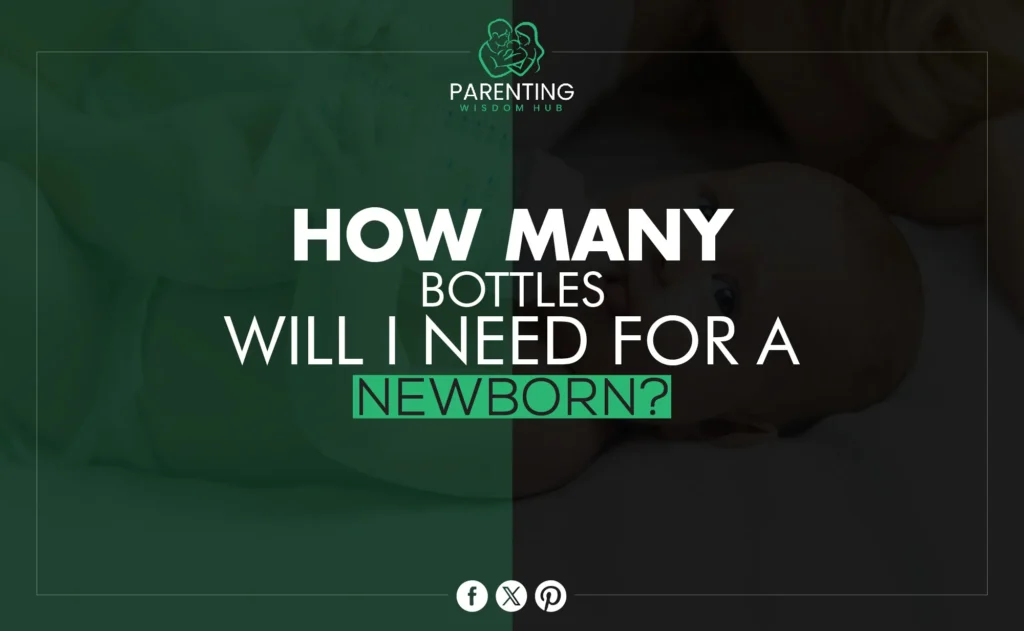Introduction
Having a newborn is thrilling and life-changing, but there is a steep learning curve. Understanding your baby’s feeding requirements is one of the most important choices you’ll make as a new parent. Ask yourself, “How many bottles will I need for a newborn?” This basic inquiry may lead to many more concerning infant bottle styles, sizes, and volumes. This detailed guide will help you choose newborn feeding basics so you may spend more time with your baby in those crucial first months.
Newborn’s Feeding Needs
Feeding your infant is crucial in the first several months. Babies eat every two to three hours, so you’ll need many bottles. Some parents breastfeed exclusively, while others bottle-feed or do both. Learn your baby’s eating habits to determine how many bottles you need.
Bottle-feeding parents need enough bottles to avoid cleaning and sterilizing them all day. Newborns eat 1.5 to 3 ounces of milk every feeding, increasing as they develop. Thus, a diversity of bottle sizes is necessary to meet their varying demands.
Consider if you’ll supplement nursing with formula or bottle-stored breast milk in addition to feedings. This decision affects how many bottles you need and your feeding regimen.
How Many Bottles Will I Need for a Newborn?
There isn’t a single answer to the question of how many bottles a newborn needs. Having at least 6 to 8 bottles on hand is a good place to start, though. With this many drinks, you should have enough for each feeding time during the day, plus extras in case something goes wrong.
If they intend to return to work or be gone from their infant for a while, some parents like having additional bottles. In these cases, 10–12 bottles may cover a day of feedings without washing.
You should also think about how and what your baby likes to eat. To keep up with their speed, some babies may need more bottles because they finish their bottles more slowly.
The Right Baby Bottle Sizes
Choosing the right size baby bottle is an important part of feeding your baby. At first, babies need smaller bottles, usually between 2 and 4 ounces. These smaller bottles are great for their little stomachs and keep them from getting too full.
As your child gets bigger, you’ll need to switch to bigger bottles (usually 8 to 9 ounces) so they can drink more milk. To be ready for your baby’s changing needs, it’s a good idea to have a mix of smaller and bigger bottles.
Remember that different bottle brands have different nipple flow rates, so you can find one that works best for your baby’s size and ability to suck. For a smooth feeding experience for both you and your baby, picking the right nipple size can help reduce problems with eating.
Types of Baby Bottles to Consider
New parents may find it hard to choose from all the different kinds of baby bottles on the market. Knowing about the different kinds can help you choose one that fits your wants and the needs of your baby.
Glass Bottles: Known for their durability and resistance to retaining odours, glass bottles are a popular choice among parents. They are easy to clean and do not contain any harmful chemicals.
Plastic Bottles: Lightweight and shatterproof, plastic bottles are convenient for on-the-go feedings. Ensure they are BPA-free for your baby’s safety.
Silicone Bottles: Flexible and easy to grip, silicone bottles are becoming increasingly popular for their soft texture and durability.
Anti-Colic Bottles: These bottles are designed with special venting systems to reduce gas and colic in babies, making them a great option for fussy eaters.
Choosing the right type of bottle can depend on factors such as your lifestyle, preferences, and your baby’s unique needs.
Bottle Feeding Tips for New Parents
Beginning to feed your baby from a bottle can be scary, but these tips will make the process easier for both of you:
Create a Routine: Establish a feeding schedule that works for your family. Consistency helps your baby know what to expect and can promote better sleep patterns.
Sterilize bottles properly: Before the first use, sterilize all bottles and nipples. Afterwards, wash them thoroughly with hot, soapy water or use a dishwasher if they are dishwasher-safe.
Choose the Right Nipple Flow: Pay attention to your baby’s cues during feeding. If they’re struggling or seem frustrated, it might be time to adjust the nipple flow.
Burp Your Baby: Remember to burp your baby after each feeding to release any trapped air and reduce discomfort.
Building a Community of Support
A support system makes parenting simpler. Joining online or local parenting clubs may provide guidance and support. Sharing advice with other parents may make motherhood more fun and less stressful.
New parents may find information and networks from several baby supply businesses. Participating in these communities helps enhance infant care and feeding knowledge.
Exploring Brand Values and Quality
Consider the brand’s ideals and quality while choosing infant bottles. Look for businesses that promote product safety, sustainability, and innovation.
Finding products that match your ideals and your baby’s requirements might be easier by reading reviews and asking other parents.
Sustainability and Eco-Friendly Options
If parents care about the environment, picking sustainable baby bottles can make a big difference. Some brands try to be more eco-friendly by using reusable materials or making their carbon footprint smaller.
Reusable drinks and items can also help you live a better life by cutting down on waste and promoting sustainability.
Baby Bottle Accessories
Besides bottles, many other things can make bottle-feeding more fun. To make things easier, you might want to buy bottle heaters, sterilizers, and drying racks.
For health reasons and to make sure that everything is clean after each use, bottle brushes and nipple-cleaning tools are a must.
Preparing for Growth and Transition
Your baby’s eating needs will change as they get bigger. Prepare for changes by slowly adding solid foods and changing the size of the bottles.
Talk to your child’s doctor about when and how to start giving your baby basic foods while still nursing. This will help your baby’s shift go smoothly.
Common Bottle-Feeding Challenges
There may be problems with bottle feeding, but being ready for them can help you get through them. Here are some common problems:
Bottle Rejection: If your baby refuses the bottle, try different nipple shapes or warm the milk to a comfortable temperature.
Gassiness and Colic: Proper burping techniques and anti-colic bottles can help lessen gas-related discomfort.
Leaking Bottles: Ensure bottles are assembled correctly and check for any defects in the bottle or nipple.
Conclusion
Parenthood is amazing yet difficult. Understanding your newborn’s feeding requirements, choosing the correct bottles, and finding helpful groups may make feeding enjoyable for both of you. There’s no one answer to “How many bottles will I need for a newborn?” Being flexible and adapting to your baby’s changing demands and preferences is ideal.
If you’re interested in infant care and nutrition, consult baby care professionals or other resources. You may enjoy every moment of motherhood with confidence with the correct information and assistance.


